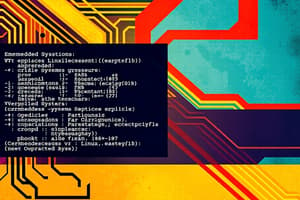Podcast
Questions and Answers
What is a key advantage of serial I/O over parallel communication in microcomputers?
What is a key advantage of serial I/O over parallel communication in microcomputers?
- Synchronous data transmission
- Faster data transmission
- Fewer physical connections (correct)
- Support for multi-device communication
Which characteristic of serial I/O ensures a defined order and timing of data transmission?
Which characteristic of serial I/O ensures a defined order and timing of data transmission?
- Sequential transmission (correct)
- Data framing protocols
- Asynchronous data transmission
- Error handling mechanisms
Which serial communication protocol uses asynchronous data transmission without a shared clock signal?
Which serial communication protocol uses asynchronous data transmission without a shared clock signal?
- UART (correct)
- SPI
- I2C
- CAN
What is a common application of serial I/O in industrial settings?
What is a common application of serial I/O in industrial settings?
What is a major disadvantage of parallel communication compared to serial I/O?
What is a major disadvantage of parallel communication compared to serial I/O?
Which of the following is NOT a characteristic of serial I/O?
Which of the following is NOT a characteristic of serial I/O?
What is a key benefit of serial I/O in terms of hardware design?
What is a key benefit of serial I/O in terms of hardware design?
What is a common error handling mechanism used in serial I/O protocols?
What is a common error handling mechanism used in serial I/O protocols?
What is the primary purpose of parity bits in UART protocol?
What is the primary purpose of parity bits in UART protocol?
Which serial communication protocol is commonly used for high-speed communication with peripherals like displays and memory chips?
Which serial communication protocol is commonly used for high-speed communication with peripherals like displays and memory chips?
What is the primary advantage of I2C protocol over other serial communication protocols?
What is the primary advantage of I2C protocol over other serial communication protocols?
In which type of applications is CAN protocol commonly used?
In which type of applications is CAN protocol commonly used?
Which of the following is NOT a characteristic of UART protocol?
Which of the following is NOT a characteristic of UART protocol?
What is the primary difference between parallel and serial communication?
What is the primary difference between parallel and serial communication?
What is the main advantage of using serial I/O in microcomputers?
What is the main advantage of using serial I/O in microcomputers?
Which of the following applications is NOT a typical use case for USB protocol?
Which of the following applications is NOT a typical use case for USB protocol?
What is the primary purpose of digital input pins in microcomputers?
What is the primary purpose of digital input pins in microcomputers?
What is the term for the Pins used to interact with external devices in microcomputers?
What is the term for the Pins used to interact with external devices in microcomputers?
What is the advantage of using digital inputs to trigger interrupts upon state changes?
What is the advantage of using digital inputs to trigger interrupts upon state changes?
What is the purpose of digital output pins in microcomputers?
What is the purpose of digital output pins in microcomputers?
What is an example of an application that uses digital inputs to detect events?
What is an example of an application that uses digital inputs to detect events?
What is the benefit of using digital inputs in control systems?
What is the benefit of using digital inputs in control systems?
What is the term for the process of regularly checking the state of digital input pins?
What is the term for the process of regularly checking the state of digital input pins?
What is the primary advantage of using digital I/O in microcomputers?
What is the primary advantage of using digital I/O in microcomputers?
Flashcards are hidden until you start studying
Study Notes
Digital I/O
- Digital I/O is a core aspect of microcomputer-based embedded systems, enabling microcomputers to interface with a wide range of devices, sensors, and actuators in industrial, consumer, and scientific domains.
Serial I/O
- Serial I/O refers to data transmission methods where information is sent one bit at a time, sequentially, over a communication channel.
- Key characteristics of Serial I/O:
- Sequential transmission of data
- Fewer wires required
- Longer communication distances supported
- Various protocols exist, each with specific characteristics
Serial Communication Protocols
- Common serial communication protocols in microcomputers:
- UART (Universal Asynchronous Receiver-Transmitter)
- Asynchronous data transmission
- Uses start and stop bits to frame data
- Employs parity bits for error detection
- SPI (Serial Peripheral Interface)
- Synchronous serial protocol
- Master-slave configuration
- Supports full-duplex communication
- I2C (Inter-Integrated Circuit)
- Synchronous serial protocol
- Supports multi-master and multi-slave configurations
- Uses a shared clock signal and data line for communication
- CAN (Controller Area Network)
- Robust serial protocol for automotive and industrial applications
- Supports multi-node communication
- Built-in error detection mechanisms
- USB (Universal Serial Bus)
- Widely used serial communication standard
- Supports different data transfer modes
- UART (Universal Asynchronous Receiver-Transmitter)
Applications of Serial I/O
- Serial I/O enables microcomputers to communicate with other microcomputers, external sensors, actuators, and devices.
- Applications include:
- Data communication in embedded systems
- Real-time operations
- Control hardware and process data
Digital I/O
- Digital I/O involves the transmission and reception of binary signals, representing two states: high (1) and low (0).
- Digital input in microcomputers:
- Enables microcomputers to receive digital signals from various sources
- Used to detect events, conditions, or states in the external environment
- Digital output in microcomputers:
- Allows microcomputers to send digital signals to control external devices
- Used in applications such as user interaction, event detection, and control systems
Studying That Suits You
Use AI to generate personalized quizzes and flashcards to suit your learning preferences.




